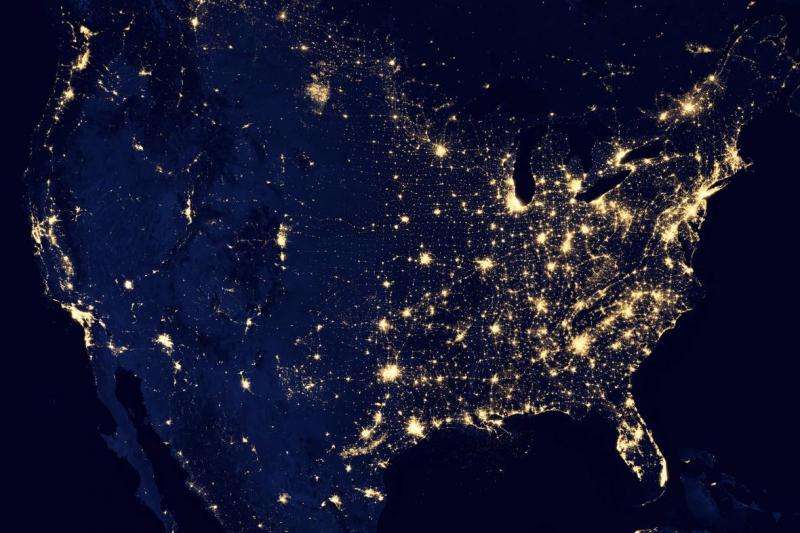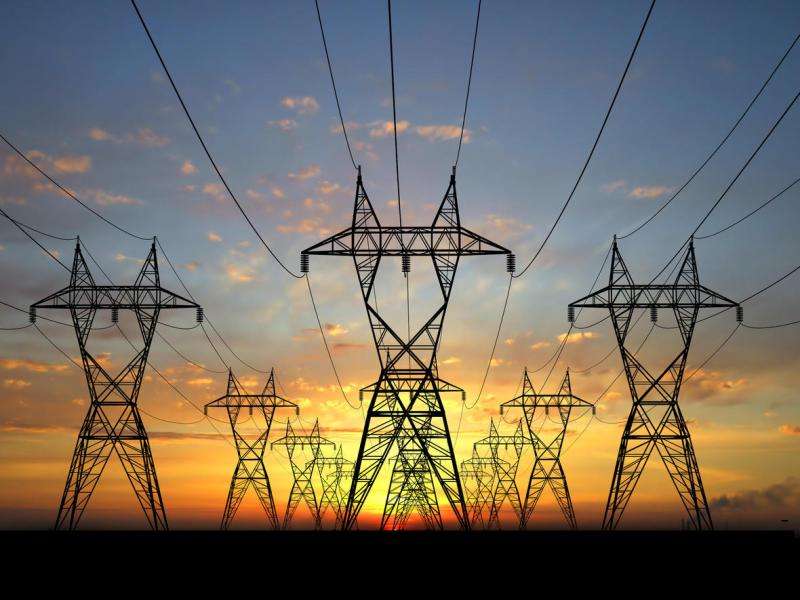How geomagnetic storms can interfere with the nation's electric-power grid systems

Scientists recently published research—including maps covering large areas of the United States—showing how the effects from intense geomagnetic storms are impacted by the Earth's electrical conductivity. This is one of the first steps towards mapping nation-wide "induction hazards." This research, a multi-agency effort led by the U.S. Geological Survey, was published in the journal Geophysical Research Letters.
A severe geomagnetic storm could disrupt the nation's power grid for months, potentially leading to widespread blackouts. Resulting damage and disruption from such an event could cost more than $1 trillion, with a full recovery time taking months to years.
It is therefore important that utility companies design, deploy, and operate electric-power grids so that risk to power-grid systems is mitigated. These newly published maps, and maps to be produced when more data become available, will help quantify risks to the power grid and inform decisions made by the Federal Energy Regulatory Commission and the North American Electric Reliability Corporation.
The new maps are based on survey data collected by the National Science Foundation's (NSF) EarthScope Program and the USGS, and observatory data collected by the USGS and the INTERMAGNET consortium.
What are Magnetic Storms?
A magnetic storm is a temporary disturbance in the Earth's magnetic field caused by the wind of electrically charged particles emitted by the Sun. The maps show the amplitude of geoelectric fields that would be generated in the Earth's surface during an intense storm. These geoelectric fields can interfere with the operation of electric-power grids, sometimes damaging high-voltage transformers and causing blackouts.
The amplitude of hazardous geoelectric fields depends on the intensity of the magnetic storms and the electrical conductivity structure of the Earth's crust (i.e. the geology and tectonics).
Multi-Agency Effort
Coordinated through the White House's Office of Science and Technology Policy and National Science and Technology Council (NSTC), this research is responsive to priorities established in the National Space Weather Strategy, released by NSTC, as well as related international initiatives for pursuing induction hazard research. This broad collaboration includes scientists from NASA, NOAA, the Institute for Defense Analyses, the Federal Energy Regulatory Commission, the Federal Emergency Management Agency, and NSF.
USGS scientists are working to better assess ground-level hazards related to space weather. The USGS Geomagnetism Program monitors variations in the Earth's magnetic field using a network of 14 ground-based observatories around the United States and its territories. The USGS Crustal Geophysics and Geochemistry Science Center carries out research and surveys of local and national scope bearing on critical earth science issues.

Next Steps
This work highlights the need for completing a national-scale magnetotelluric survey and for additional geomagnetic monitoring stations to complete and improve assessments of geoelectric hazards for the continental United States. For this, a high-priority area is the northeast United States, a region that includes several major metropolitan centers and corresponding electric-power grid infrastructure, all of which are situated on top of complicated geological and tectonic structures and at latitudes where geomagnetic activity can be locally intense.
In terms of future research, USGS scientists are working on other related research projects, including scenario mapping of geoelectric fields for specific storms and developing a real-time mapping capability.
Case Studies
The vulnerability of modern society to geoelectric hazards was demonstrated in March 1989, when an intense magnetic storm caused the collapse of the entire Canadian Hydro-Québec power-grid system, leaving 6 million people without electricity for 9 hours.
More recently, the Halloween magnetic storm of October 2003 induced measurable (though manageable) currents in power-grid systems in Scotland and caused operational failures in grid systems in Sweden.
Some hypothetical "scenario" analyses anticipate that the future occurrence of a rare magnetic superstorm, possibly as intense as the "Carrington event" of 1859, would cause widespread and long-lasting loss of electric-power for the United States and other countries.
More information: Jeffrey J. Love et al. Geoelectric hazard maps for the continental United States, Geophysical Research Letters (2016). DOI: 10.1002/2016GL070469
Journal information: Geophysical Research Letters
Provided by United States Geological Survey



















